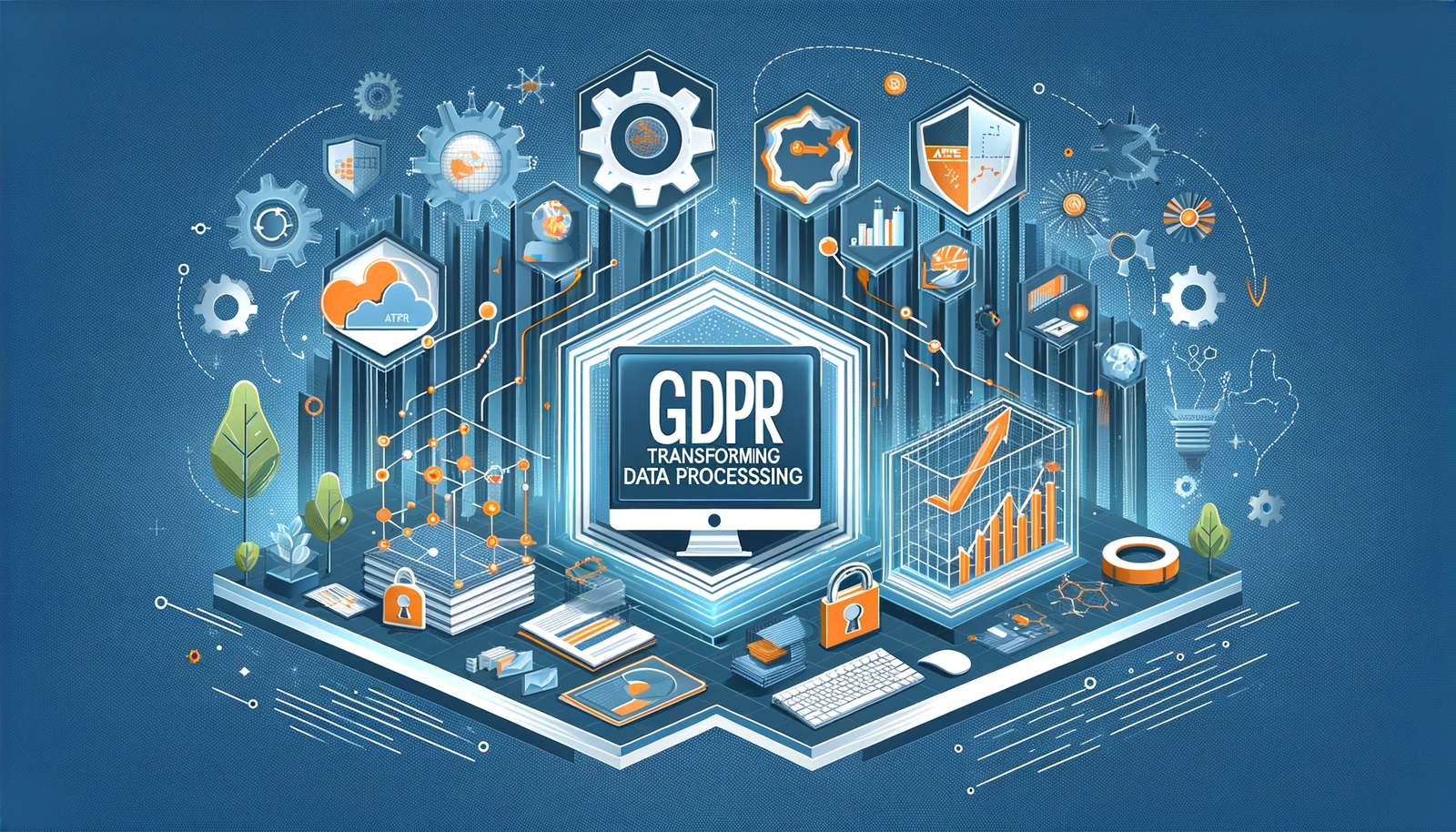
The Impact of GDPR on Data Processing and Privacy Policies
In the present digitalized period, where information is as important as money, the Overall Information Security Guideline addresses a critical achievement in data assurance and protection. Carried out in May 2018, GDPR has upset how associations handle and cycle individual information. This broad regulation, vital in the domain of data assurance guidelines, influences organizations and people alike, across the European Association and then some.
GDPR Overview: More Than Just a Regulation
Something Beyond a Guideline At its center, GDPR is intended to give people more command over their data while putting rigid commitments on associations that interact with this information. It’s not only a bunch of rules; it’s a key change in the way to deal with protection strategy changes and data protection. From private companies to global partnerships, GDPR’s impact is expansive, commanding a reconsideration of practices and systems concerning individual information.
The Essence of GDPR: Protecting Personal Data
Protecting personal data For what reason is GDPR so significant? In a scene where information breaches and abuse of personal data are progressively normal, GDPR remains a defense safeguarding people’s security freedoms. It ensures transparency, responsibility, and the protection of personal data—an impression of society’s developing interest in security in a hyper-associated world.
By fathoming the substance and ramifications of GDPR, organizations can consent to legitimate prerequisites as well as encourage entrustment with their clients, preparing for a safer and more cognizant future.
Table of Contents

Section 1: Decoding GDPR: A Comprehensive Guide
In a world progressively determined by information, figuring out the overall information security guideline (GDPR) is urgent. This part digs into what GDPR is, its verifiable setting, and its key parts, offering a thorough outline of this essential guideline.
What is GDPR?
The Overall Information Security Guideline (General Data Protection Regulation GDPR) is an earth-shattering data insurance regulation that happened in the European Association in May 2018. Its essential goal is to give people command over their data while forcing severe principles on the individuals who host and cycle this information, paying little mind to area. GDPR characterizes personal information as any data connected with a recognizable individual, essentially increasing the extent of what is private information.
History and Development of GDPR
The beginning of GDPR was a reaction to the developing computerized scene and the requirement for additional strong information insurance norms. Its improvement was affected by the quick development of computerized innovations, the expansion of individual information utilization, and expanding public concern over protection freedoms. Supplanting the obsolete 1995 Information Security Mandate, GDPR was intended to blend information protection regulations across Europe, improving people’s security privileges and mirroring the new ways that information is utilized in the 21st hundred years.
Key Components of GDPR
GDPR is based on a few key standards, including straightforwardness, reason constraint, information minimization, precision, capacity impediment, respectability, and responsibility. These standards structure the underpinning of GDPR’s way to deal with information security, accentuating the significance of legitimate, fair, and straightforward handling of individual information.
Moreover, GDPR provides people with a few rights, including:
- The option to get to their information.
- The option to be neglected is information eradication.
- The right to information conveyability.
- The option to be educated about information breaks.
- The option to have mistaken information amended.
These parts guarantee that people have critical command over their information, while associations are expected to comply with severe rules in their information handling exercises.
Section 2: Transforming Data Processing: GDPR's Role
The presentation of GDPR significantly affects how associations process information. This segment investigates the change in information handling rehearsals post-GDPR, the consistency prerequisites, and certifiable contextual analyses representing the guideline’s belongings.
1. Before and After GDPR
Pre-GDPR Era:
Information handling rehearsals fluctuated fundamentally, with numerous associations working under less severe protection guidelines. The emphasis was, to a greater degree, toward the utility of information, frequently to the detriment of security.
Post-GDPR Shift:
The execution of GDPR denoted a huge shift, presenting stricter controls and more noteworthy straightforwardness. Associations should currently guarantee that individual information is gathered legitimately and under severe circumstances. They’re likewise obliged to safeguard it from abuse and double-dealing, as well as to regard the freedoms of information proprietors.
2. GDPR Compliance in Data Processing
Consistency in information handling includes a few key stages:
- Assent The board: guaranteeing clear and express assent for information handling.
- Information Security Effect Appraisals: Assessing gambles related to information handling exercises.
- Information Minimization: Gathering just the information that is essential for the expected reason.
- Straightforwardness and Responsibility: Being straightforward about information use and having powerful responsibility systems set up.
Associations should consistently audit and update their information handling exercises to keep up with GDPR.
The Impact of GDPR on Data Processing and Privacy Policies
Section 3: Redefining Privacy: GDPR's Influence on Privacy Policies
The implementation of GDPR has required significant changes in protection strategies, directing associations to embrace more straightforward and client-driven approaches. This segment talks about the advancement of security arrangements under GDPR, frames best practices for consistency, and gives instances of agreeable protection approaches.
1. Changes in Privacy Policies Due to GDPR
With the appearance of GDPR, security approaches have undergone a huge change. Key changes include:
Expanded Straightforwardness: Security arrangements are currently more itemized, obviously illustrating how and why individual information is gathered and handled.
Client Assent: Arrangements should expressly express the requirement for client assent for information handling.
Information Subject Privileges: Improved accentuation on the freedoms of people in regards to their own information, including access, correction, cancellation, and information conveyability.
These progressions mirror GDPR’s emphasis on safeguarding individual information privileges and guaranteeing associations handle individual data dependably.
2. Best Practices for GDPR-Agreeable Protection Approaches
Making a GDPR-consistent protection strategy includes:
Clarity and Accessibility: Arrangements ought to be written in clear, direct language and be effectively open to clients.
Ordinary Updates: Consistently survey and update the security strategy to mirror any progress in information handling rehearsals.
Detailed Information: Give exhaustive insights concerning information assortment, handling, stockpiling, and sharing practices.
Client Privileges: Frame the freedoms of clients concerning their information, including how they can practice these freedoms.
Following these prescribed procedures guarantees that security strategies conform to GDPR as well as fabricate entrust with clients by exhibiting a promise to information insurance.
3. Instances of GDPR Consistent Protection Solution
Model 1: A main online business stage’s security strategy, which frames exhaustively how client information is utilized for customized marketing and the actions set up to protect this data.
Model 2: A virtual entertainment organization’s strategy, which gives clear, compact data on information assortment, client privileges, and contact data for information protection concerns.
These models outline successful correspondence of information practices and client privileges, filling in as benchmarks for GDPR-consistent protection approaches.
Section 4: Navigating Challenges: GDPR Compliance Solutions
Complying with GDPR’s tough guidelines isn’t without its difficulties. This segment expects to distinguish normal obstacles associations face in accomplishing consistency and recommends powerful systems and answers for defeating them.
1. Normal GDPR Consistence Difficulties
Associations face a few moves in their excursion to GDPR consistency:
- Figuring out the Extent of GDPR: Numerous organizations battle to get a handle on the degree of GDPR’s prerequisites completely.
- Information Planning and Analyzation: Distinguishing and sorting the kinds of information handled can be complicated and asset escalated.
- Innovation and Foundation Overhauls: Ensuring IT frameworks and cycles are GDPR-consistent frequently requires huge speculation.
- Preparing and Mindfulness: Developing a culture of information security and guaranteeing all staff know about GDPR prerequisites is a significant endeavor.
These difficulties can appear to be overwhelming, yet with the right methodology, they can be successfully made due.
2. Solutions for Effective GDPR Compliance
To explore these difficulties, associations can take on a few systems:
- Master Interview: Looking for direction from GDPR specialists or lawful guides can give clearness on consistence necessities.
- Information The executive’s Apparatuses: Carrying out hearty information the board and security programming can smooth out consistence endeavors.
- Staff Preparing Projects: Normal instructional courses can guarantee staff are educated about GDPR and its suggestions for their jobs.
- Ceaseless Checking and Improvement: Routinely evaluating and refreshing information security procedures to keep up with consistency and adjust to any progressions in GDPR guidelines or business tasks.
By utilizing these solutions, associations can conform to GDPR as well as upgrade the general data management works, prompting improved proficiency and client trust.
Conclusion
The Overall Information Security Guideline (General Data Protection Regulation GDPR) has certainly reclassified the scene of data insurance and protection solutions. Its extensive effect has constrained associations overall to reanalyze and patch up their data dealing with rehearsals. GDPR isn’t simply an administrative prerequisite; it represents a key change in the way to deal with personal data, stressing regard for personal security and the option to control one’s data.
The meaning of GDPR reaches out past consistency. It addresses a pledge to work on moral information, upgrading trust among organizations and purchasers. During a time when data breaks and protection concerns are wild, sticking to GDPR mitigates legitimate dangers as well as positions associations as capable and dependable substances.
Source of inspiration: considering GDPR’s significance, it’s basic for associations and people alike to consistently audit and update their information handling and security strategies. Remaining informed and versatile despite developing data security guidelines is pivotal. Whether you’re an entrepreneur, a data security official, or a concerned customer, making proactive strides towards understanding and executing GDPR standards isn’t simply a legitimate commitment but, all the same, an ethical basis in the present digital world.
By embracing GDPR’s system, we can collectively foster a safer, more transparent digital environment where privacy is not just a policy, but a core value.
1. What is the General Data Protection Regulation (GDPR)?
The General Data Protection Regulation (GDPR) is an extensive information assurance regulation that happened in the European Association in May 2018. It's intended to give EU residents more command over their own information and normalize information protection regulations across Europe. GDPR influences any association, paying little mind to the area, that processes the individual information of EU occupants.
2. How has GDPR changed data processing practices?
GDPR has changed information handling rehearsals by accentuating information subjects' freedoms, information assurance by plan, and severe assent necessities. Associations are presently expected to be more straightforward about how they gather, use, and offer individual information. They should guarantee that individual information is handled legally, reasonably, and safely. Moreover, GDPR has provoked organizations to execute stricter information safety efforts and security strategies.
3. What are the key components of a GDPR-compliant privacy policy?
A GDPR-consistent protection strategy ought to incorporate clear data about the sorts of information gathered, the reason for information assortment, information maintenance periods, and insights concerning information subjects' privileges (like access, correction, eradication, and conveyability). It ought to likewise make sense of the legitimate reason for handling information, how information is secured, and strategies for telling people and experts in the event of an information break.
4. What are the penalties for non-compliance with GDPR?
Resistance to GDPR can bring about significant punishments. Fines can reach up to €20 million or 4% of the organization's yearly worldwide turnover, whichever is higher. The seriousness of the punishment relies upon the idea of the infringement, including factors like the span of the encroachment, the purposeful or careless person, and any actions taken by the organization to alleviate the harm.
Don't Stop Here
MORE TO EXPLORE

Governmnent Tender/Bids
Unlocking Opportunities: Empowering Efficiency and Success in Government Tenders – Your Back Office Solution.

Integration of AI in Data Sciences
Our application of AI in data science is used for accelerating the development of highly accurate models for predicting outcomes and patterns in data, as well as automation and machine learning.

Back Office
Calling
Seize Every Opportunity: Elevate Sales, Bookings, and Appointments with our Dynamic Back Office Calling Solutions Service.
For Other Services
Connect with us here

Digital Marketing
Services
Elevate your brand through tailored digital campaigns, spanning SEO, social media, and compelling content, ensuring optimal ROI in a dynamic online landscape.

Artificial Intelligence Services and Products
Leverage AI’s potential for data-driven insights, predictive analytics, and process automation, driving personalized experiences and operational excellence.
